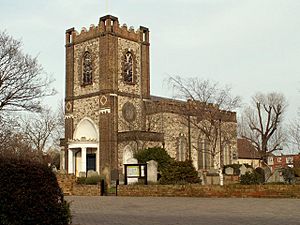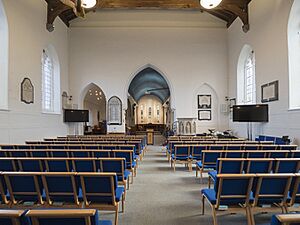St Peter and St Paul, Dagenham facts for kids
Quick facts for kids St Peter and St Paul, Dagenham |
|
|---|---|
| Dagenham Parish Church of Saint Peter and Saint Paul | |
 |
|
| Location | Church Lane, Dagenham, Greater London, RM10 9UL |
| Country | England |
| Denomination | Church of England |
| Previous denomination | Roman Catholic |
| Churchmanship | Conservative Evangelical |
| History | |
| Status | Active |
| Dedication | Saint Peter Saint Paul |
| Architecture | |
| Functional status | Parish Church |
| Heritage designation | Grade II* listed building |
| Administration | |
| Parish | Dagenham |
| Deanery | Deanery of Barking & Dagenham |
| Archdeaconry | Archdeaconry of Barking |
| Episcopal area | Barking Episcopal Area |
| Diocese | Diocese of Chelmsford |
| Province | Province of Canterbury |
St. Peter and St. Paul, also known as Dagenham Parish Church, is a historic Church of England building. It is located in Dagenham, a part of London that used to be in Essex. This church has a long history, dating back to medieval times. Most of what you see today was rebuilt in the early 1800s.
Contents
History of Dagenham Parish Church
Building the First Church
The first St. Peter and St. Paul church was built a very long time ago, in the early 1200s. The land for the church was given by Barking Abbey, a famous monastery nearby.
The original church was made from a type of stone called Kentish ragstone. This stone was brought across the River Thames. A part of the church, called the North Chapel, was described as "new" in a document from 1475. The arches connecting the chancel and the North Chapel show building styles from the late 1400s.
Changes During the Reformation
During a time known as the Reformation, many churches in England faced big changes. St. Peter and St. Paul's church was affected too. Many of its valuable items were taken away.
Later, with help from the Fanshawe family, the church was repaired and made stronger. A stone support, called a buttress, was added to the outside of the east wall. You can still see this buttress today.
The Tower Collapse and Rebuilding
By 1770, the church building was in a dangerous state. The tower's foundations were weak, causing it to push on other parts of the church. Some temporary repairs were done, and plans were made to rebuild the tower.
However, before the rebuilding could start, the tower suddenly fell down. This happened on a Sunday morning in December 1800. Luckily, no one was hurt because the vicar was late with the keys. Everyone was still waiting outside for the service to begin.
The collapse destroyed a large part of the church, including the nave and the south aisle. Only the chancel and the North Chapel remained standing. The entire damaged part of the church had to be rebuilt.
The new construction used some of the old stone, along with brown brick. The rebuilding was finished by 1805. The new tower even had a spire, which was later removed.
The Architect's Vision
The person who designed the rebuilt church was William Mason. He proudly carved his name above the west door. One writer, Ian Nairn, described Mason's style as "Marvellous nonsense" and "pure froth." This means it was very decorative and playful, not serious.
The Church Bells
In 1804, a set of six bells was made for the new tower. They were cast by Thomas Mears at the famous Whitechapel Bell Foundry. The largest bell had a long list of names carved on it. These were the people who helped rebuild the church.
In 1933, the bells were remade by Gillet and Johnston. They were hung in a new wooden frame. Five years later, in 1938, two more bells were added by John Taylor & Co. This completed a set of eight bells.
Later Improvements
Over the years, the church continued to be updated:
- In 1841, a new gallery was added inside the church.
- In 1844, an organ was installed in the gallery. Before this, a village orchestra used to play music there.
- By 1877, the floor of the Nave was lowered by 15 inches. This is why the windows seem quite high today.
- At the same time, the organ was moved, and the old pulpit was replaced. The church was also refurnished with new wooden benches.
- In 1913, the church roof was replaced.
- In 1921, the spire on the tower was removed.
- In 1938, electricity was installed, replacing the old gas lamps. The organ pipes were moved to the gallery and powered by electricity. The organ's control panel was also made larger.
In 1954, St. Peter and St. Paul's church was recognized as a Grade II* listed building. This means it is a very important historical building.
St. Peter and St. Paul Today
St. Peter and St. Paul's church is still very active today. People meet there every Sunday morning at 10:30 AM. There are also various groups that meet during the week.
The church is part of the Church of England. It is led by a bishop named Rod Thomas.


